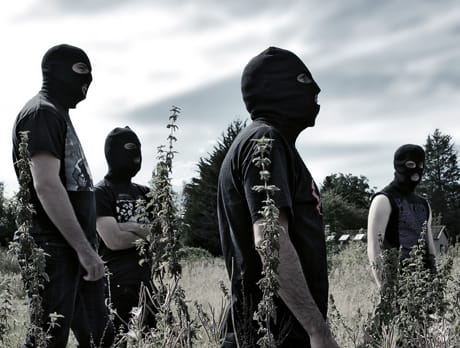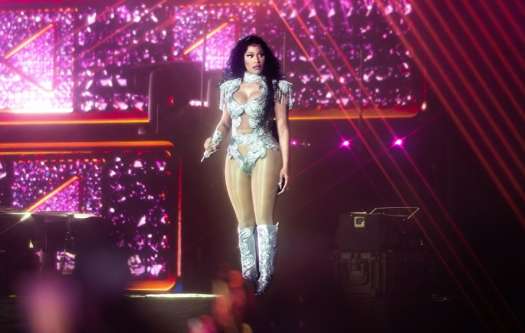There isn't a great deal of aggressive music that profoundly disturbs the listener in a primitive, primal way, an aspect that causes the hair on the back of the neck to stand up and something deep in the pit of the gut to feel cold and sour. Dragged Into Sunlight are one of the few bands capable of producing music that feels genuinely dangerous. Their last full-length, Hatred for Mankind, was a lovely atrocity, but dwelt a little too much on the theatricality of evil. Widowmaker has pushed beyond the manicured surface of foulness into a rotten heart. The three-song album is best consumed as a single monumental track, one that follows the basic three-act structure of any narrative. It's not often one encounters music this conceptually sophisticated and well executed that also, in its most secret depths, simply hates you.
Dragged Into Sunlight's sound and identity are defined by a relentless negativity and staring into the void. What draws you to regard that darkness so closely and try to conjure its shape in music?
Vocalist T: Hatred, depression, pessimism and loneliness are all feelings innate to every human. Darkness isn't so much an attraction for Dragged Into Sunlight as it is a reality. Senses operate on a sliding scale and for those involved, Dragged Into Sunlight are often a culmination of extremities into a single expression. Expression isn't found in the final production, rather it lurks somewhere in the interaction between notes and finer details. Consider every detail as an additional brush stroke and an additional layer to the madness. Darkness is often very natural and without shape. It is a moulded and thorough process; it is Dragged Into Sunlight. The reality is that darkness, like happiness, can be nurtured.
Despite the swarming, seeping negativity of DIS, I often find the experience of listening to the music cleansing — not cathartic like much aggressive music, but almost akin to a process of exorcism. Is this the result of a deliberate choice? Do you want your audience to cough up their demons?
Dragged Into Sunlight are a process for the listener as well as those involved. The approach is definitely deliberate, in that we purge everything we have into every note and the aim is very much a meeting of minds. Each message is unique and like the music we listen to, it is there to be absorbed. We're not looking for a reaction, we're looking for understanding. The reaction is inconsequential.
You recently performed at Maryland Death Fest, which has a notorious celebratory atmosphere. Did you find this helped or hindered your aesthetic?
Maryland Death Fest was a very special occasion. Realistically, it didn't help or hinder our aesthetic, as we do what we do regardless. But to have seen bands such as Demigod, Godflesh, Rwake and Infernal Stronghold on the same day was an honour.
You often perform in such a way that your features and identities are obscured, obfuscating yourselves behind smoke, turning your back to the audience, identifying yourselves only by single initials. What inspires this move towards self-erasure?
We're all very accomplished individuals. Nowadays, we live in a world where nothing is secret. Extreme music is infected. You have grown men running around in make-up. Ask yourself whether it is the listener who needs to know the musician or the musician who wants the listener to know who is behind the music? Dragged Into Sunlight have no requirement for the same exposure, our recordings and achievements individually, as well as collectively, speak for themselves.
Tell me about your forthcoming album, Widowmaker. How have your lyrical or conceptual themes evolved since Hatred for Mankind?
Widowmaker is a conceptual recording; however, a common misunderstanding is that conceptual music should be expressed vocally. Except then it isn't a concept — it's a story. For Dragged Into Sunlight, there is no mandate for words. Consider a piece of classical or contemporary art, the starting point for any such piece is the underlying influence and feeling. Widowmaker demonstrates a similar approach. While it may be an entirely different flesh to Hatred for Mankind, it is a root that draws from the same source and one that can co-exist. Widowmaker is slower, heavier and louder, yet there is no shift for Dragged Into Sunlight. The recording draws from a different pool of influence and one that may not have been as apparent on Hatred for Mankind.
Justin Barlett created some incredible art for the cover of Hatred for Mankind. Will you be working with him again for Widowmaker?
Sindre Foss did the artwork for Widowmaker. The artwork for Widowmaker is unique and accurately reflects the recording. Similarly to Hatred for Mankind, we're very grateful to have worked alongside such a great mind.
So much of Widowmaker is about drawn-out tension, waiting and ache. It is both an incredibly patient and impatient album. What inspired this?
The writing and recording processes ran concurrently. Consequently, you're left with a very natural style and sound, which are almost impossible to replicate.
Do you believe there is room for beauty in Dragged Into Sunlight's sound — delicacy in the negativity?
That depends on the individual's definition of beauty. Some of the most beautiful paintings in the world focus on death. Loneliness can be beautiful, take the Aokigahara Forest, for example.
With the release of Windowmaker, do you have any plans to tour more extensively than you have in the past, perhaps spending some more time in North America/Canada?
We'll see.
Spending so much time staring into the abyss that it blinks back, it must seem almost friendly now. Does anything really disturb you?
Unfortunately not.
Dragged Into Sunlight's sound and identity are defined by a relentless negativity and staring into the void. What draws you to regard that darkness so closely and try to conjure its shape in music?
Vocalist T: Hatred, depression, pessimism and loneliness are all feelings innate to every human. Darkness isn't so much an attraction for Dragged Into Sunlight as it is a reality. Senses operate on a sliding scale and for those involved, Dragged Into Sunlight are often a culmination of extremities into a single expression. Expression isn't found in the final production, rather it lurks somewhere in the interaction between notes and finer details. Consider every detail as an additional brush stroke and an additional layer to the madness. Darkness is often very natural and without shape. It is a moulded and thorough process; it is Dragged Into Sunlight. The reality is that darkness, like happiness, can be nurtured.
Despite the swarming, seeping negativity of DIS, I often find the experience of listening to the music cleansing — not cathartic like much aggressive music, but almost akin to a process of exorcism. Is this the result of a deliberate choice? Do you want your audience to cough up their demons?
Dragged Into Sunlight are a process for the listener as well as those involved. The approach is definitely deliberate, in that we purge everything we have into every note and the aim is very much a meeting of minds. Each message is unique and like the music we listen to, it is there to be absorbed. We're not looking for a reaction, we're looking for understanding. The reaction is inconsequential.
You recently performed at Maryland Death Fest, which has a notorious celebratory atmosphere. Did you find this helped or hindered your aesthetic?
Maryland Death Fest was a very special occasion. Realistically, it didn't help or hinder our aesthetic, as we do what we do regardless. But to have seen bands such as Demigod, Godflesh, Rwake and Infernal Stronghold on the same day was an honour.
You often perform in such a way that your features and identities are obscured, obfuscating yourselves behind smoke, turning your back to the audience, identifying yourselves only by single initials. What inspires this move towards self-erasure?
We're all very accomplished individuals. Nowadays, we live in a world where nothing is secret. Extreme music is infected. You have grown men running around in make-up. Ask yourself whether it is the listener who needs to know the musician or the musician who wants the listener to know who is behind the music? Dragged Into Sunlight have no requirement for the same exposure, our recordings and achievements individually, as well as collectively, speak for themselves.
Tell me about your forthcoming album, Widowmaker. How have your lyrical or conceptual themes evolved since Hatred for Mankind?
Widowmaker is a conceptual recording; however, a common misunderstanding is that conceptual music should be expressed vocally. Except then it isn't a concept — it's a story. For Dragged Into Sunlight, there is no mandate for words. Consider a piece of classical or contemporary art, the starting point for any such piece is the underlying influence and feeling. Widowmaker demonstrates a similar approach. While it may be an entirely different flesh to Hatred for Mankind, it is a root that draws from the same source and one that can co-exist. Widowmaker is slower, heavier and louder, yet there is no shift for Dragged Into Sunlight. The recording draws from a different pool of influence and one that may not have been as apparent on Hatred for Mankind.
Justin Barlett created some incredible art for the cover of Hatred for Mankind. Will you be working with him again for Widowmaker?
Sindre Foss did the artwork for Widowmaker. The artwork for Widowmaker is unique and accurately reflects the recording. Similarly to Hatred for Mankind, we're very grateful to have worked alongside such a great mind.
So much of Widowmaker is about drawn-out tension, waiting and ache. It is both an incredibly patient and impatient album. What inspired this?
The writing and recording processes ran concurrently. Consequently, you're left with a very natural style and sound, which are almost impossible to replicate.
Do you believe there is room for beauty in Dragged Into Sunlight's sound — delicacy in the negativity?
That depends on the individual's definition of beauty. Some of the most beautiful paintings in the world focus on death. Loneliness can be beautiful, take the Aokigahara Forest, for example.
With the release of Windowmaker, do you have any plans to tour more extensively than you have in the past, perhaps spending some more time in North America/Canada?
We'll see.
Spending so much time staring into the abyss that it blinks back, it must seem almost friendly now. Does anything really disturb you?
Unfortunately not.




